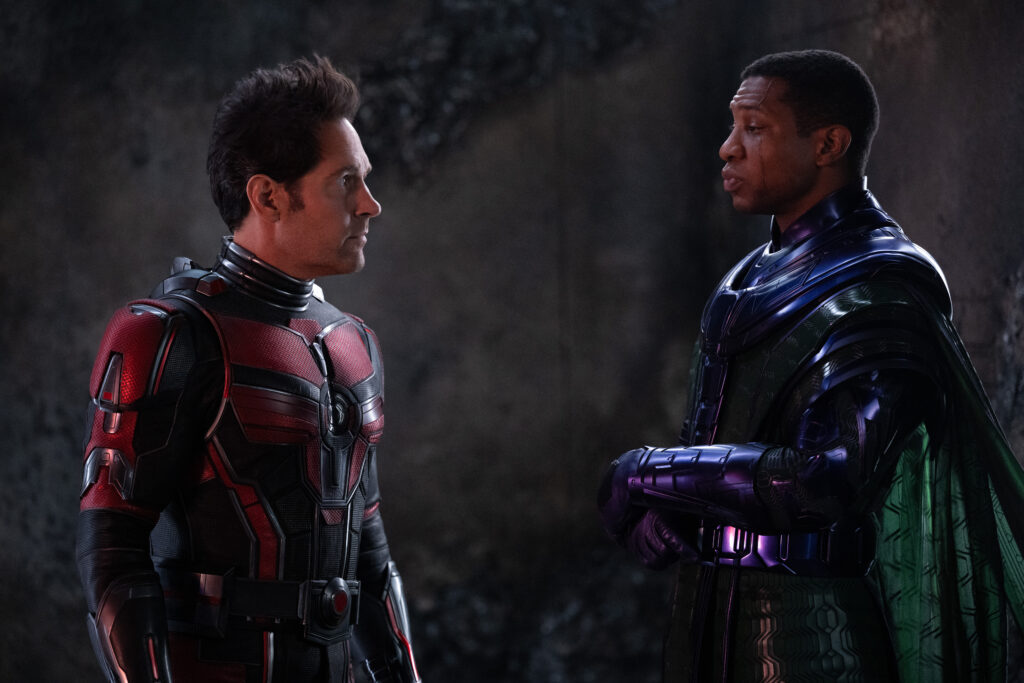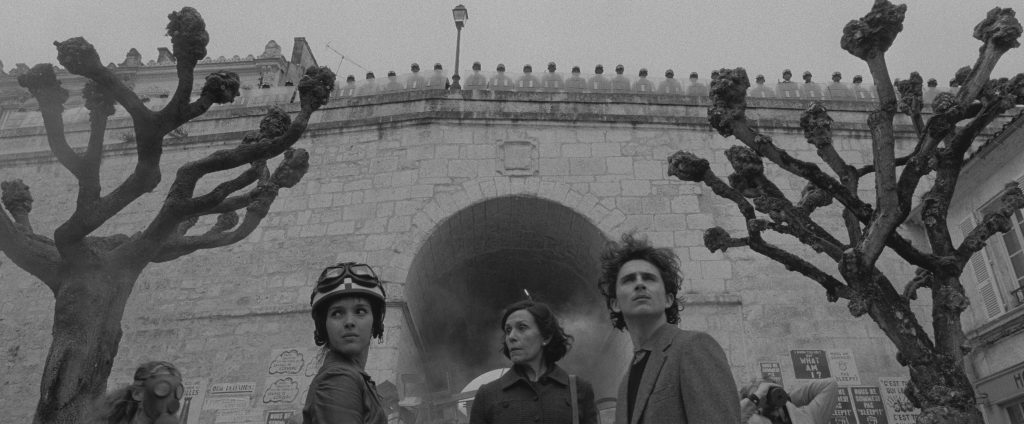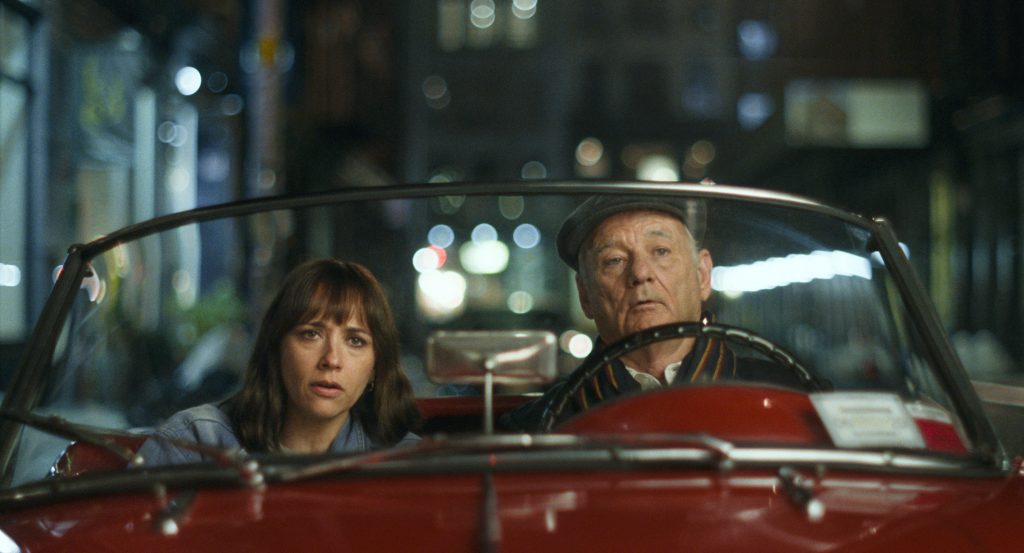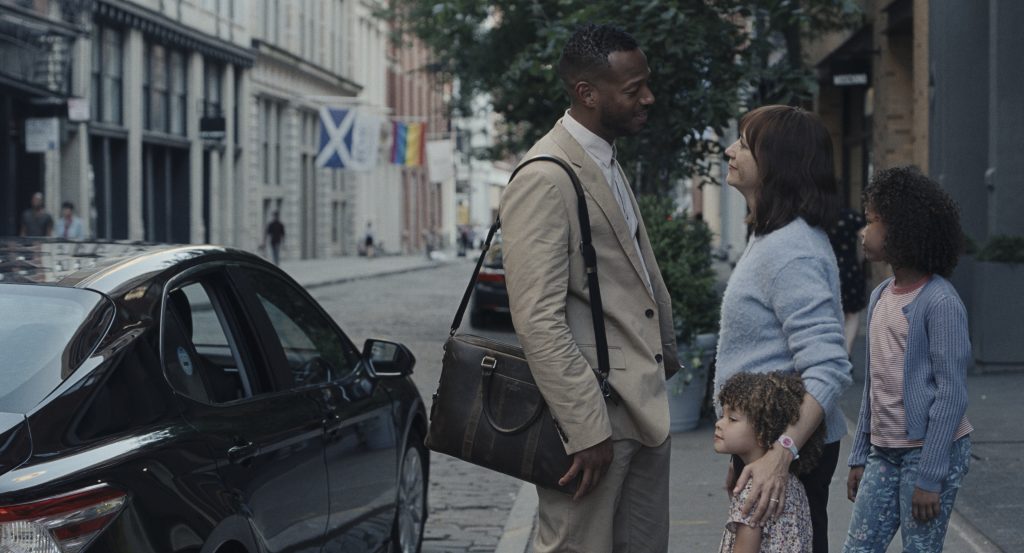February 14, 2023
by Carla Hay

“Ant-Man and the Wasp: Quantumania”
Directed by Peyton Reed
Culture Representation: Taking place in an underworld universe called Quantumania, and briefly in San Francisco, the sci-fi/fantasy/action film “Ant-Man and the Wasp: Quantumania” (based on Marvel Comics characters) features a cast of predominantly white characters (with some African Americans, Asians and Latinos) representing superheroes, regular humans and alien creatures.
Culture Clash: Scott Lang (also known as superhero Ant-Man), his formerly estranged daughter Cassie Lang, Scott’s girlfriend Hope Van Dyne (also known as superhero The Wasp) and Hope’s parents get dragged into the Quantum Realm, where they have to battle evil forces, led by Kang the Conqueror.
Culture Audience: Besides appealing to the obvious target audience of Marvel movie fans, “Ant-Man and the Wasp: Quantumania” will appeal primarily to people who are fans of the movie’s headliners and superhero movies that are very predictable, corny and formulaic.

“Ant-Man and the Wasp: Quantumania” is a quantum mess. It’s bad enough that it recycles tired clichés of Marvel movies. This uneven superhero movie also rips off 1977’s “Star Wars” in many ways. Jonathan Majors’ standout performance can’t save this substandard spectacle. “Ant-Man and the Wasp: Quantumania” is supposed to be the start of Phase 5 of the Marvel Cinematic Universe (MCU). The movie will no doubt make blockbuster money, as all MCU movies have done so far. But in terms of creativity, this disappointing film is a stumble right out of the gate for the MCU’s Phase 5.
One of the biggest problems with “Ant-Man and the Wasp: Quantumania” is how it awkwardly balances comedy with action. The jokes are the most juvenile, tackiest and least funny so far in the “Ant-Man” movie series, which began with 2015’s “Ant-Man” and continued with 2018’s “Ant-Man and the Wasp.” Peyton Reed is the director of all three movies, which makes his creative choices even more baffling for “Quantumania,” which has a drastically different tone (and lower quality as a result) than the first two “Ant-Man” movies.
When writer/director Taika Waititi directed 2017’s “Thor: Ragnarok” (the third “Thor” movie of the MCU), he radically changed the tone of the “Thor” movie series to make it fit his signature comedic style: goofy and slightly offbeat. Waititi did the same for 2022’s “Thor: Love and Thunder,” to less well-received results. But it doesn’t explain why the third “Ant-Man” movie has gone so far off-course when it’s had the same director for the first three “Ant-Man” movies.
Much of the blame for why “Ant-Man and the Wasp: Quantumania” has turned into a hodgepodge of bad jokes, sci-fi rehashes and superhero triteness has to with the movie’s screenplay, which is the feature-film debut of Jeff Loveness. Loveness’ previous writing experience is for shows such as the Adult Swim animated series “Rick and Morty,” the ABC variety talk show “Jimmy Kimmel Live,” the 2012 Primetime Emmy Awards, the 2016 Primetime Emmy Awards and the 2017 Academy Awards, with these particular award shows all hosted by Jimmy Kimmel. All of these TV shows require a different skill set than what’s required to write an entertaining superhero movie. Unfortunately, hiring a TV writer with no experience in writing movies turned out to be a huge mistake for “Ant-Man and the Wasp: Quantumania” and Marvel Studios.
In “Ant-Man and the Wasp: Quantumania,” the story begins right after the events of 2019’s “Avengers: Endgame.” Scott Lang (played by Paul Rudd), a former petty criminal also known as Ant-Man (whose superpower is being able to change the height of his body by wearing a special superhero suit), is a happily retired superhero living in his hometown in San Francisco. Scott has cashed in on his superhero fame by writing a memoir titled “Look Out for the Little Guy!,” where he talks about his superhero experiences and what they have taught him about life.
The movie shows Scott reading excerpts from his book at a book signing, but a few people there still mistake him for the more famous Spider-Man. Scott tells the small audience at this book signing, “From now on, the only job I want is to be a dad.” However, the movie unrealistically shows that middle-aged Scott, in his superhero “retirement,” has chosen to take a low-paying job as a customer service employee at a local Baskin-Robbins store. He has been named Employee of the Century because of his celebrity status as Ant-Man.
It’s really the movie’s obvious brand placement for Baskin-Robbins, but viewers are given the weak explanation that Scott took the job because he loves ice cream. It all looks very awkward and fake. The movie’s overload of Baskin-Robbins brand promotion is extremely annoying. There’s even a scene where a Scott Lang look-alike named Jack, who’s a Baskin-Robbins employee, gets in on the fight action. It’s all so crass and stupid.
Get used to seeing a lot of “look-alikes” in this movie, because much of it takes place in an alternate universe where clones of people and clones of creatures can show up randomly. Scott is trying to reconnect with his 18-year-old daughter Cassandra “Cassie” Lang (played by Kathryn Newton), who was raised primarily by Scott’s ex-wife while Scott was off doing other things, such as being a criminal-turned-superhero. Cassie has turned into a social justice warrior who’s involved in civil protests.
In the beginning of the movie, Cassie has landed in the San Francisco County Jail, because she was arrested for shrinking a police car because the police were trying to clear out an illegal homeless camp. Scott and his intelligent and sassy girlfriend Hope Van Dyne (played by Evangeline Lilly), also known as superhero The Wasp (she can turn into a wasp mutant and can also shrink her body height), have arrived at the jail to retrieve Cassie. It’s how Scott finds out to his dismay that Cassie is also an aspiring scientist who invented her own shrinkage suit. She hasn’t given herself a superhero name though.
Scott thinks Cassie is too young to get involved in superhero antics. Cassie thinks Scott has become too complacent and thinks he should care more about making the world a better place. Hope and Cassie have bonded with each other because Hope is now the leader of the Pym Van Dyne Foundation, which uses Pym Particle (the body morphing invention used by Ant-Man and The Wasp) for humanitarian causes. Of course, it’s already been revealed in the “Quantumania” trailer that Scott will literally be sucked back into superhero activities, whether he likes it or not.
Hope’s parents are scientists Hank Pym (played by Michael Douglas) and Janet Van Dyne (played by Michelle Pfeiffer), who were the original Ant-Man and The Wasp. As the movie over-explains and over-repeats in pedestrian dialogue, Janet was trapped in an alternative universe called the Quantum Realm for 30 years and doesn’t like to talk about what she experienced there. Janet returned to Earth when Hank rescued her from the Quantum Realm, as shown in “Ant-Man and the Wasp.”
However, “Ant-Man and the Wasp: Quantumania” makes a big misstep by giving away in an opening scene that Janet actually was acquainted with the movie’s chief villain: Kang the Conequeror (played by Majors) while she was in the Quantum Realm, where Janet and Kang are seen escaping an attack from a giant insect-like creature. The movie should have left it a mystery until the right moment to show that Janet already knew this villain. Instead, this part of the plot is revealed too early in the film.
At any rate, Scott finds out that Hank, Janet, Hope and Cassie have been studying ant science. Hope and Cassie in particular want to use this science to explore the Quantum Realm, but Janet has no interest in going back there. Janet won’t say why, but she will eventually make a confession later in the movie.
Janet describes the Quantum Realm as a “place with no time and space. It’s a secret universe beneath ours.” To Janet’s horror, Cassie announces to Janet, Scott, Hank and Hope (while they are all in the scientific lab) that Cassie has been secretly sending signals to the Quantum Realm. Janet frantically tries to turn off the signal machine.
And faster than you can say “inferior Marvel movie sequel,” all five of them are sucked into the Quantum Realm, which looks like a half-baked “Star Wars” universe. For much the first third of the movie, Scott and Cassie are separated from Janet, Hank and Hope. Scott and Cassie spend a lot of time bickering over how much Cassie might or might not be ready to use her superhero suit. (Too late. We already know she will.)
Janet, Hank and Hope spend much of their time talking in vague tones about a mysterious “he” and “him” leader who has wreaked havoc on the Quantum Realm. Anyone can easily figure out that the “he” and “him” is Kang the Conqueror. There’s no reason to make him sound like “Harry Potter” villain Voldemort, also known in the “Harry Potter” series as He Who Shall Not Be Named. It’s yet another way that “Ant-Man and the Wasp: Quantumania” takes ideas from other sci-fi/fantasy franchises.
Reed says in the production notes for “Ant-Man and the Wasp: Quantumania” where he got some of the visual influences for the movie: “We pulled together a lot of visual inspiration—everything from electron microscope photography to heavy metal magazine images from the ’70s and ’80s. I collected all of these images from old science-fiction paperback book covers—artists like John Harris, Paul Laird, Richard M. Powers. Those paintings were evocative and really moody. We liked that feel and tone for the look of the Quantum Realm.”
Reed curiously didn’t mention “Star Wars,” which is undoubtedly the biggest influence on “Ant-Man and the Wasp: Quantumania.” The Quantum Realm’s terrain looks like a desert in some areas and looks like a crater-filled planet in other areas. The desert scenes look too much like the desert realm of Tatooine in “Star Wars,” while the hooded costumes worn by the Quantum Realm residents look an awful lot like the costumes worn by Tusken Raiders from “Star Wars.”
And if the “Star Wars” similarities for the production design and costume design weren’t enough, “Ant-Man and the Wasp: Quantumania” also imitates the Mos Eisley cantina scene in “Star Wars,” but doesn’t make it nearly as fun and interesting to watch. Hank, Janet and Hope end up in a place called Axia Restaurant, which is basically a “Star Wars” cantina look-alike filled with unusual-looking creatures. There’s no memorable music at the Axia Restaurant, like there was in the Mos Eisley cantina. Christophe Beck’s musical score for “Ant-Man and the Wasp: Quantumania” is serviceable and unremarkable.
It’s at Axia Restaurant where Hope and Hank meet the smirking Lord Kylar (played by Bill Murray) for the first time. Janet already knows Lord Kylar, who says he is neither a human nor a machine. Lord Kylar, who is the governor of the Axia community, hints that he and Janet used to be lovers when she was in the Quantum Realm.
“I had needs,” Janet tells Hank and Hope in a somewhat defensive and uncomfortable tone. Hope then has to hear Hank talk about an ex-girlfriend. And she acts like a prudish teen who doesn’t want to think about her parents having love lives before they met each other. This is the type of time-wasting dialogue that’s supposed to pass as “comedy” in the movie.
Even though Murray shares top billing for “Ant-Man and the Wasp: Quantumania,” his role in the movie is just a cameo that lasts for less than 15 minutes. It’s ineffective and misguided casting because he’s not convincing as this fictional character. All viewers will think is that this is Murray in a space-alien costume playing a version of himself.
As for the other inhabitants of the Quantum Realm, it’s a random mix of beings who look like humans and those who are very non-human in appearance, including a lot of jellyfish-like creatures that float around in space. As soon as Scott and Cassie arrive in the Quantum Realm, they are force-fed a red ooze by a creature named Veb (voiced by David Dastmalchian), because this red ooze will help these humans understand the language of the Quantum Realm residents. Dastmalchian had the role of Kurt (a member of Scott’s posse) in the first two “Ant-Man” movies. Veb is an underdeveloped character that is meant to be comedic, but Veb’s jokes fall very flat.
The Quantum Realm residents predictably greet these newcomers from Earth with reactions that range from curiosity to hostility. Jentorra (played by Katy O’Brian) is an anti-Kang freedom fighter who scowls a lot and has to learn to trust these Earth heroes to be her allies. Xolum (played by James Cutler, also known as Jamie Andrew Cutler) is a loyal soldier and totally generic sidekick of Jentorra.
Quaz (played by William Jackson Harper) is a psychic/telepath, whose only purpose in the movie is to make people uncomfortable by reading their thoughts and saying their thoughts out loud. His revelations are supposed to be amusing, but they’re not really all that funny. Randall Park has a small and non-essential role as FBI agent Jimmy Woo.
Corey Stoll returns as “Ant-Man” villain Darren Cross, also known as Yellowjacket, who has now been shrunken by Kang into a subatomic lackey with an oversized head known as M.O.D.O.K., which stands for Mechanized Organism Designed Only for Killing. M.O.D.O.K. looks like a floating head and delivers some of the few genuinely comedic moments in “Ant-Man and the Wasp: Quantumania.” Various characters in the movie have horrified reactions to seeing Darren look so drastically different as M.O.D.O.K., but this gag is repeated too much and loses its impact by the middle of the movie.
As for Kang, Majors’ performance is the only one that brings a certain gravitas to the rampant foolishness and smarm that stink up “Ant-Man and the Wasp: Quantumania.” Majors brings a combination of menace and melancholy to his role, but it’s wasted in a movie that is hell-bent on trying to be more like Waititi’s “Thor” movies. The rest of the cast members’ performances aren’t bad, but they’re not special either. Kang’s soldiers are Quantumnauts, which are as anonymous and soulless as the mostly CGI creations that they are.
Unfortunately, the big showdown fight scene is lot more montonous and unimaginative than it should have been. It ends abruptly and in a way that has been done already (and done much better) in many other sci-fi/fantasy/action movies. As for the movie’s visual effects, it’s a shame that a movie with this big budget can make visual effects look so cheap and shoddy. There are scenes that make it obvious where the “blue screens” and “green screens” were.
A mid-credits scene and end-credits scene basically show the return of a major character from the movie. The end-credits scene is a nod to the Disney+ series “Loki.” As an example of how “Ant-Man and the Wasp: Quantumania” has a sitcom tone to it, the movie uses John Sebastian’s 1976 hit “Welcome Back” (the theme from the sitcom “Welcome Back, Kotter”) as bookends to the movie. A big-budget superhero movie should not look like a second-rate sitcom, which is what “Ant-Man and the Wasp: Quantumania” has turned out to be.
Marvel Studios will release “Ant-Man and the Wasp: Quantumania” in U.S. cinemas on February 17, 2023.




